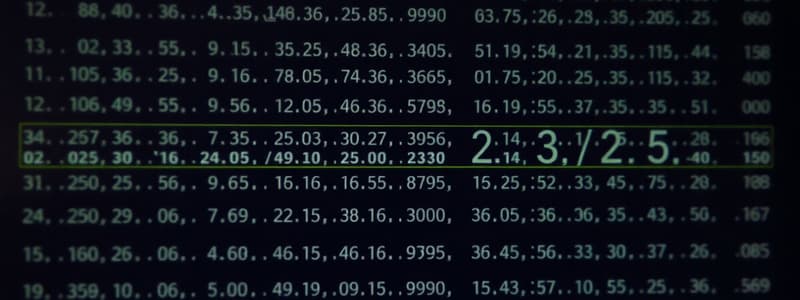Podcast
Questions and Answers
What is dynamic programming?
What is dynamic programming?
A method for solving complex problems by breaking them down into simpler subproblems.
What is the optimal substructure in the context of dynamic programming?
What is the optimal substructure in the context of dynamic programming?
The optimal solution to a problem can be constructed from optimal solutions of its subproblems.
What distinguishes the 0/1 knapsack problem from the fractional knapsack problem?
What distinguishes the 0/1 knapsack problem from the fractional knapsack problem?
In the 0/1 knapsack problem, items cannot be broken; in the fractional knapsack problem, items can be taken in smaller pieces.
What is the goal of the knapsack problem?
What is the goal of the knapsack problem?
What does the S-Flow algorithm focus on?
What does the S-Flow algorithm focus on?
What principle states that any optimal solution to a problem is composed of optimal solutions to its subproblems?
What principle states that any optimal solution to a problem is composed of optimal solutions to its subproblems?
What is the purpose of Warshall's algorithm?
What is the purpose of Warshall's algorithm?
Dynamic programming requires the subproblems to be independent.
Dynamic programming requires the subproblems to be independent.
The flow into a node minus the flow out of a node equals the amount of flow generated at that ______.
The flow into a node minus the flow out of a node equals the amount of flow generated at that ______.
Flashcards are hidden until you start studying
Study Notes
Data Analysis Algorithms
Dynamic Programming
- Definition: A method for solving complex problems by breaking them down into simpler subproblems. It is applicable when the subproblems overlap.
- Key Concepts:
- Optimal Substructure: The optimal solution to a problem can be constructed from optimal solutions of its subproblems.
- Overlapping Subproblems: The problem can be broken down into smaller, repeated problems.
- Approach:
- Store results of subproblems to avoid redundant calculations (memoization).
- Build solutions in a bottom-up manner.
Knapsack Problem
- Definition: A problem in combinatorial optimization where the goal is to maximize the total value in a knapsack without exceeding its weight capacity.
- Types:
- 0/1 Knapsack Problem: Items cannot be broken, and each item can be taken or left (yes/no).
- Fractional Knapsack Problem: Items can be broken into smaller pieces; allows for taking fractions of items.
- Dynamic Programming Solution:
- Create a table to store maximum value at each weight capacity.
- Iterate through each item and update the table based on inclusion/exclusion.
S-Flow Algorithm
- Definition: A method related to network flow problems, focusing on maximizing flow in a network with certain constraints.
- Key Principles:
- Flow Conservation: The flow into a node minus the flow out of a node equals the amount of flow generated at that node.
- Capacity Constraints: Flow cannot exceed the specified capacities of edges.
- Application: Used in logistics, telecommunications, and transportation problems.
Principle of Optimality (Warshall's Algorithm)
- Definition: A principle stating that any optimal solution to a problem is composed of optimal solutions to its subproblems.
- Application:
- Used in dynamic programming to develop algorithms that find shortest paths in weighted graphs.
- Warshall’s Algorithm:
- A method for finding transitive closure of a directed graph.
- Iterative process that updates a matrix to indicate reachable states.
- Use Cases: Shortest path finding, network connectivity.
Summary
Data analysis algorithms leverage concepts of dynamic programming to optimize solving complex problems like the knapsack problem and flow management in networks, supported by essential principles such as the Principle of Optimality and specific algorithms like Warshall's.
Dynamic Programming
- A problem-solving technique that breaks down complex problems into simpler, overlapping subproblems
- It involves finding the optimal solution to each subproblem and then combining these solutions to find the optimal solution to the original problem.
- It requires that the problem possesses the properties of optimal substructure and overlapping subproblems.
- The algorithm stores the results of solved subproblems to avoid redundant calculations.
Knapsack Problem
- A classic optimization problem where the goal is to maximize the value of items selected while staying within a weight constraint.
- It has two main variants: the 0/1 Knapsack Problem and the Fractional Knapsack Problem.
- The 0/1 Knapsack Problem allows only whole items, while the Fractional Knapsack Problem allows for taking fractions of items.
- Dynamic programming is a common approach to solving this problem, using a table to store the maximum value achievable at each weight capacity.
S-Flow Algorithm
- A network flow algorithm that focuses on maximizing the flow through a network while adhering to specific constraints.
- Key principles include flow conservation (flow in equals flow out), capacity constraints (flow cannot exceed edge capacity), and the goal of maximizing the total flow through the network.
- Used in applications involving resource allocation, logistics, telecommunications, and transportation.
Principle of Optimality
- This principle states that any optimal solution to a problem is composed of optimal solutions to its subproblems.
- It is often applied in dynamic programming algorithms to solve problems that involve finding shortest paths.
Warshall's Algorithm
- A method for finding the transitive closure of a directed graph.
- It works by iteratively updating a matrix that represents the reachability of nodes in the graph.
- It is a useful method for tasks like shortest path finding and network connectivity.
Studying That Suits You
Use AI to generate personalized quizzes and flashcards to suit your learning preferences.





